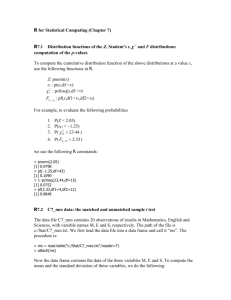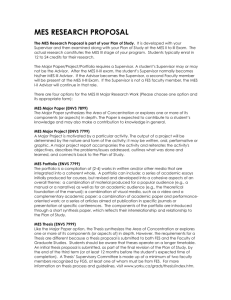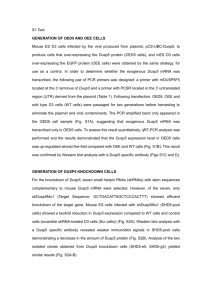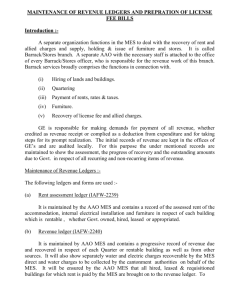Review Journal-Produksi Antibodi Monoklonal
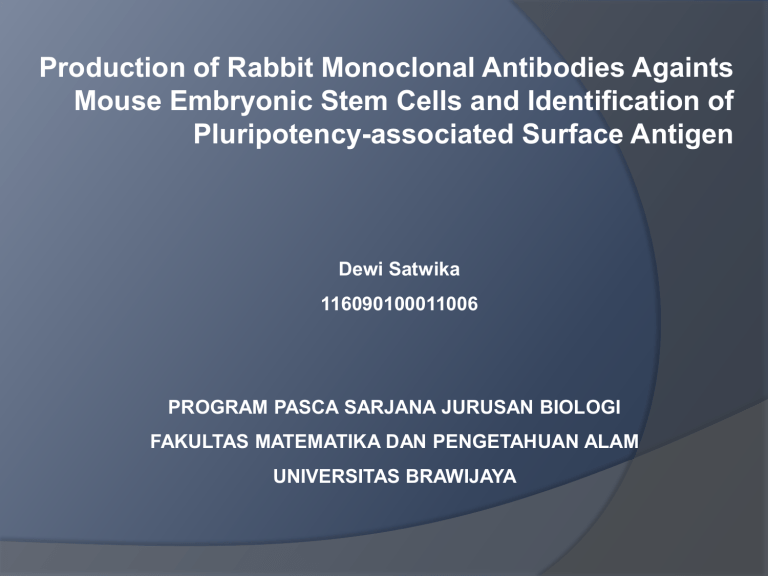
Production of Rabbit Monoclonal Antibodies Againts
Mouse Embryonic Stem Cells and Identification of
Pluripotency-associated Surface Antigen
Dewi Satwika
116090100011006
PROGRAM PASCA SARJANA JURUSAN BIOLOGI
FAKULTAS MATEMATIKA DAN PENGETAHUAN ALAM
UNIVERSITAS BRAWIJAYA
Embryonic stem cells
(ES cells) pluripotent stem cells potential for regenerative medicine
ES cells surface molecules detection of antigen genomics proteomics
Monoclonal antibody hibridoma
Efficient method for surface marker identification
Mus muscullus
Kohler and milstein
Potential to recogniize new surface molecule on
?
mouse ES cells
Smaller Ab repertoire higher affinity and specificity in recognizing conformational and modified epitopes
Rabbit New Zealend
Immunotolerant to cell surface Ag on mouse ES cells larger antibody repertoire
METHODS
Injected subcutaneously with
10 8 mES D3 cell line
3 months old
1 week serum collection
2 weeks
The mES cell lines D3 were cultured on mitomycin Ctreated mouse embryonic fibroblasts (MEFs)
Resuspended in 1 ml PBS injected intravenously with 10 8 mES cells suspended in 1 ml of
PBS emulsified with CFA in a 1:1 (v/v) ratio
Booster using mES cell suspension emulsified in IFA
Sacrifice
Spleen
240E-1 cell line
Added PEG to fuse hibridoma mES cells culture in MEF
Supernatant hibridoma centrifuge
FITC conjugated goat anti-rabbit sec. Ab clone
propagated
Culture supernatant clone
Positive clone
Cells lysate
5 ×10 8 F9 EC cells by ultrasonication in lysis buffer
Culture supernatant
Protein-A conjugated resin
Fluoresence microscopy
Western blotting
Staining primary and second Ab
SDS
PAGE
Blocked with blocking solution c Putative antigens eluted with a
2.5 mM citrate solution
Fixed in
4% PFA cells
Flowcytometry
RESULT
After subcloning, 240 remained positive. Six monoclones of each subclone plate were expanded and cryopreserved.
These antibodies can be divided into four major types based on the cellular locations of their targeted antigens: membrane (A), extracellular matrix (B), nucleus (C) and cytoplasm
(or cytoskeleton) (D).
Fig. 1. Staining patterns of different rMabs on mES D3 cells and MEFs.
Fig. 2. ICC staining using the 20 rMabs.
Twenty Mab that were able to bind to mES cells. These Ab showed different staining patterns.
7 antibodies showed nuclear or diffused staining while 13 were cytosolic/membraneous.
All but two antibodies stained positively on mES cells
From 20 positively rMabs
10 antibodies targeted the extracellular epitopes of cell surface proteins for more than 5% of the mES cells
Positively stained by three antibodies, ZjuESrMab3,
ZjuESrMab29 and
ZjuESrMab61, decreased more than 50% upon mES cell differentiation
Fig. 3. Flow cytometry analysis using the 20 rabbit monoclonal antibodies. A: Staining of monoclonal antibodies on mES D3 cells. B: Staining of monoclonal antibodies on mES D3 cells that were spontaneously differentiated for 3 days
ZjuESrMab29 and ZjuESrMab61 did not detect any protein in the western blot analysis, suggesting that they might target conformational epitopes on live mES cells.
ICC staining with ZjuESrMab29 faded after three days of spontaneous differentiation of mES cells cultured in a monolayer.The percentage of positive cells decreased to about 1%.
one specifically stained band of approximately 42 KDa was observed for
ZjuESrMab29
LC-MS/MS analysis identified the protein as
GM-CSFR
α.
A small increase in staining was detected after nine days of monolayer differentiation The number of positively stained cells decreased to about 2% after four days of differentiation into embryoid bodies
(Ebs)
The expression of GM-
CSFR α in the testis may serve as a marker of ES cells and GS cells.
expression of GM-
CSFR α decreases upon mES cell differentiation and is restricted to adult tissues, suggesting that GMCSFR α could serve as a new pluripotency- associated surface marker for mES cells.
Immunohistochemical staining of adult mouse tissues with ZjuESrMab29. ZjuESrMab29 stained strongly in the testis, stained weakly in the restricted regions of the kidney and spleen and did not stain in the liver, heart, brain or lung.
Immunohistochemical analysis showed that ZjuESrMab29 stained strongly in the testis, stained weakly in the restricted, perivascular regions of the kidney and spleen and did not stain in the liver, heart, brain or lung
